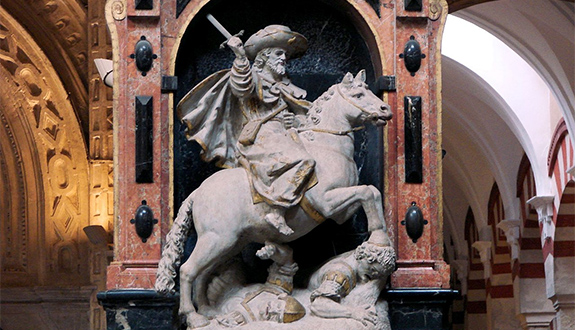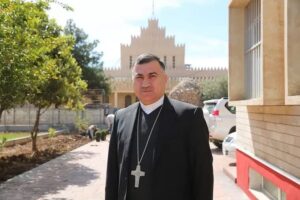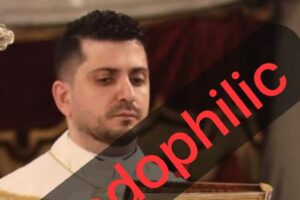Despite the appalling specter of Islamic terrorism now gripping Europe—the attacks and slaughter in Munich, Nice, Brussels, Paris—Europeans, while once united in faith, aren’t likely to seek the intercession of St. James today
Mary Jo Anderson

Statue of St. James, the Moor Slayer, Mosque–Cathedral of Córdoba, Cordoba, Spain (Marshall Henrie/Wikipedia)
“Europe will return to the faith or she will perish.” — Hilaire Belloc, Europe and the Faith.
Soon after the March, 2004 bombing of Madrid’s Atocha train station by Al Qaeda partisans, there were calls to remove the statue of Saint James the Moorslayer from Spain’s famous cathedral in Santiago de Compostela. The Madrid carnage—191 dead, 2000 more injured—stunned the country. The government hoped that Muslims would find Spain friendlier if the “offensive” Matamoros was banished. But the Spanish people protested vigorously against removal of an iconic image that figures so prominently in the nation’s history.
Today is the feast day of Saint James the Greater. Millions of pilgrims have trekked across four ancient pilgrim paths that thread through Europe, converging in the Pyrenees, then across northwestern Spain to the tomb of St. James at his shrine in Santiago de Compostela (St. James of the Starry Field).
Modern pilgrims walk the Camino, “The Way of St. James,” in the footsteps of great pilgrims of the past, including St. Godric of Norfolk, El Cid, St. Francis of Assisi, John of Gaunt, and Lorenzo de Medici. Henry II, father of Richard the Lionhearted, offered to make the pilgrimage in expiation for the murder of St. Thomas Becket. Historians credit the forging of a common European identity to the Camino de Santiago. Through the centuries Christian pilgrims have built great monasteries, abbeys, and hospitals along these roads, along with a shared culture—art, architecture, fashion, literature, and faith.
Pilgrimage fervor suffered when the Reformation split Europe, dividing European identities and loyalties. Interest surged again in the 1980s; today more than a quarter million pilgrims a year set off for Santiago where archeologists have found inscriptions for the Apostle’s two disciples, and where Christians believe the Son of Zebedee himself lies in a silver casket.
The apostle James, along with his brother John, and Simon Peter were Jesus’ confidantes. They alone among the apostles were present at the Transfiguration and in the Garden of Gethsemane. James preached in Spain after the disciples went forth following the Resurrection. He was beheaded by Herod Agrippa in 42 A.D., the first apostle to die, the first apostle martyred. His followers returned James’ body to Spain, burying his remains in Galicia in the northwestern corner of the peninsula. And there the apostle lay forgotten until 813, when most of Spain groaned under the Saracen boot.
A Muslim storm burst from North Africa over most of Iberia in 711 A.D. taking Christians captive, pillaging towns and swarming north over the Pyrenees into France. By 800, Christians had been backed into the northernmost region and a humiliating tribute of a 100 virgins per year was demanded of local governors.
The twelfth-century collection of history, verse, liturgy, and travelogue about the Camino, known as Codex Calixtinus, records a legend that Charlemagne himself had a vision of a knightly protector who identified himself as St. James (Sant Iago, Santiago), the apostle of Jesus Christ:
Look you, my body is in Galicia, but no man knoweth where and the Saracens oppress the land…the starry sky signifies you shall go to Galicia at the head of a great host and after you all peoples shall come in pilgrimage even till the end of time…and your name shall abide in the memory of man until the Day of Judgment.
The warrior emperor was to liberate the roadway that ran to the tomb. In Galicia, James’ burial crypt had been rediscovered in 813 and a small chapel was built (by Bishop Teodomir) to protect it. Myth or miracle, a rout now known as the Battle of Clavijo was fought in the year 844 by desperate Christians with their backs against the mountains, led by Ramiro 1 of Asturias. Suddenly, there appeared a heavenly horseman, sword aloft, who slew every Muslim in his path: Santiago Matamoros. Inspired by their champion, the faithful began the reconquest of Spain.
Seven hundred years later Queen Isabella finally recovered all of Spain from Muslim rule. She immediately pawned her jewels to finance Christopher Columbus. Isabella, who built hospitals for pilgrims along the Camino, knew that Christianity must evangelize any lands beyond the horizon, lest Mohammed’s forces dominate the world. Today’s politically correct agenda overlooks Isabella’s urgent hope. But there is confirmation of her intent in a letter from Columbus to an official “Treat the Natives with the utmost kindness. Protect them from all wrong and insult…and ever bear in mind that their majesties are more desirous of the conversion of natives than any riches to be derived from them.”
Despite the appalling specter of Islamic terrorism now gripping Europe—the attacks and slaughter in Munich, Nice, Brussels, Paris—Europeans, while once united in faith, aren’t likely to seek the intercession of St. James today. Secularism has so eroded the shared basis of European (Western) identity that any such appeal is unthinkable. Worse, an ideology of secular progressivism is protected at all costs. The larger terror to many in European bureaucracy is that religion, especially Christianity, is the basis for a culture that thrives and endures.
Fundamentally, cohesiveness as a culture requires more than a pragmatic economic and political cooperation. Who, after all, feels a kindred affection for political cooperation? Culture requires an engagement of fidelity, loyalty, and a lasting rationale for voluntary cooperation beyond the power of states to enforce. And even more culture must open a space for the human expression of love beyond oneself. The recent Brexit vote is a stark check to bureaucrats who failed to understand this human need. Unless such love is nurtured, citizens view each other as utilitarian units for economic or political gain rather than as neighbors.
Pope John Paul II cautioned as much at Santiago de Compostela during World youth day 1989, saying that “… amid the dense mist which looms before us, when the awareness of the common Christian vocation is dimmed” man must not “let himself be taken in by ideologies and cultures of death and destruction.” His warning was especially poignant for two reasons.
First, European Christendom had survived the spread of militant Islam. Trendy revisionist history paints the Crusades as justification for settling the score between The West and Islam. But even a cursory reading of events unravels that theory. Until the 16th century, Islam was the superpower with glittering cities and magnificent armies, and Europe little more than a third-rate backwater. The great early Christian sees located in Antioch, Jerusalem and Alexandria as well as medieval Constantinople had long been obliterated by political Islam. But Europe, by heaven’s providence, survived the onslaught with miraculous moments such as the Battle of Lepanto in 1571 and the decisive Battle of Vienna, 1683 when the military might of the Ottoman Empire was repelled.
Secondly, only five years later the saintly pontiff’s plea to leaders to recognize Europe’s Christian heritage in the first European constitution was rebuffed. Already Islamic influences were widely suffered in Europe. A Constitution that set out the heritage and the rights of Europe’s Christian institutions was urgent, yet ignored. Pope John Paul II understood Hilaire Belloc’s “Europe is the Faith, and the Faith is Europe.”
Europe’s great minds had by then long warned that abandonment of Europe’s Christian roots would imperil its Civilization. And most of them pointed to Islam as the invader that could vanquish a sclerotic culture emptied of its essential identity, its central idea. Consider the politically-incorrect assessment of St. Thomas Aquinas, who flatly stated: “He (Mohammed) seduced the people by promises of carnal pleasure to which the concupiscence of the flesh urges us… Those who believed in him were brutal men and desert wanderers, utterly ignorant of all divine teaching, through whose numbers Mohammed forced others to become his follower’s by the violence of his arms.” (Summa Contra Gentiles, Book 1,Ch.16, art.4).
Widespread, reactionary furor followed the publication of Pope Benedict XVI’s Regensburg address. By 2006 it was clear that the mushrooming Muslim populations in Europe understood their identity, clearly rejected the culture of their adopted lands and that Europeans lacked a coherent response, either philosophically or politically. Noted political philosopher Fr. James Schall, SJ, summarized the tumult: “He addressed an issue that did, to be sure, come to world attention because of Islamic militancy. This issue was stated succinctly: ‘Is it reasonable, or does God will, to spread one’s religion by violence?’ This was a question asked by practically everyone in the world who thought of the implications of “suicide bombings,” or about the earlier holy wars — jihad — in Islamic history, wars largely, though not exclusively, against Christian lands. The issue is the deliberate choice of violent means as the proper way to propagate a religion, together with a theological justification to do so.”
G.K. Chesterton’s insight into the permanence of Islamic violence has proven most prescient, “There is in Islam a paradox which is perhaps a permanent menace. The great creed born in the desert creates a kind of ecstasy out of the very emptiness …A void is made in the heart of Islam which has to be filled up again and again by a mere repetition of the revolution that founded it. There are no sacraments; the only thing that can happen is a sort of apocalypse, as unique as the end of the world; so the apocalypse can only be repeated and the world end again and again.”
Today, Christians and the vestiges of Christian cultures are witness and victim to apocalyptic Islam. William Kilpatrick, author of Christianity, Islam and Atheism: The Struggle for the Soul of the West, wrote recently that the West must consider the worst case scenario:
In the worst case scenario, we must contemplate not only the departure of the pope, but also the end of Christianity in Europe. Judging by the ongoing persecution of Christians in the Middle East, Africa, and other parts of the Muslim world, one can’t afford to be too rosy about the outlook for European Christians. Indeed, Christian Europe faces the greatest threat to its existence since the armies of Sultan Mehmet IV converged on Vienna in 1683.
As Raymond Cardinal Burke stated directly in a recent interview, Catholic leaders seeking to be tolerant, often make the mistake “to simply think that Islam is a religion like the Catholic faith or the Jewish faith.” Attempts to not offend Islam are both ineffective and contrary to the Christian mission to proclaim the Gospel with boldness, whether in the first century, the ninth century, or the 21st century.
St. James, pray for us.

A view from the “Way of St. James”, June 2016 (Photo courtesy of Emily G. Anderson)
Mary Jo Anderson is a Catholic journalist and speaker whose articles and commentaries on politics, religion, and culture appear in a variety of publications. She is a frequent guest on EWTN’s “Abundant Life,” and her monthly “Global Watch” radio program is heard on EWTN radio affiliates nationwide. She was appointed to the United States Conference of Catholic Bishops National Advisory Council (NAC), 2010-2014 and served as member of the NAC Executive Committee in 2011. Follow her on Twitter @maryjoanderson3.
http://www.catholicworldreport.com/Item/4949/europe_islam_and_saint_james_the_moorslayer.aspx















